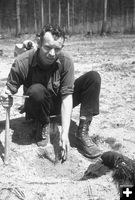

Russ Hudson
Russ Hudson plants a ponderosa pine in the Little Wolf Creek area in 1974 during the first progeny tests conducted by the Inland Empire Tree Improvement Cooperative. (Photo courtesy of Inland Empire Tree Improvement Cooperative)
|
|
Retired forester honored for work with genetics
by Brent Shrum, Kootenai Valley Record
September 17, 2009
Longtime Libby forester Russ Hudsonís pioneering work to foster healthier and more productive trees is being recognized with the naming of a gene archive on the University of Idahoís experimental forest in his honor.
The Russell H. Hudson Gene Archive represents the culmination of work started by Hudson and other foresters more than 40 years ago. A longtime employee of St. Regis Paper Co. and later Champion International, Hudsonís interest in genetics was sparked when he attended a 1960 meeting in Seattle along with colleagues John McBride, Mark Schoknecht and Howard Heiner and heard a forester from Denmarkís presentation on genetic work being done with larch in Scandinavia. By the late 1960s, Hudson had helped organize the Inland Empire Tree Improvement Cooperative, through which private and public landowners began working to identify, preserve and propagate genetically superior trees.
The initial focus was on ponderosa pine. Foresters from all over the region picked out individual trees that had desirable characteristics such as being straight and not forked, with small limbs and no obvious disease or insect problems. Their choices were then rated by a selection team, and collection of seeds started in 1968.
"Mainly we were looking for the best trees in the best stands," Hudson said.
Seeds were kept in cold storage until there were enough to begin sowing. The first progeny tests, in which trees were planted in the Little Wolf Creek area, began in 1974. Trees were later planted at several other locations in both Montana and Idaho.
The trees that had been planted in the progeny tests were monitored over time to see if they displayed the characteristics of the parent trees. When superior genetics were confirmed, grafts were taken from the parent trees for seed production.
The program was expanded to include additional species including western white pine, western larch, Douglas fir and lodgepole pine.
"I guess the bottom line is we didnít realize it at the time, but we managed to save the best of the best that we could find," Hudson said. "A lot of those stands are long gone, unfortunately."
Most of the work was done on a volunteer basis by members of the cooperative, but as the program grew the need for a paid director became apparent. An agreement was reached with the University of Idaho, and a director was hired to split his time between teaching duties and managing the cooperative.
Hudson chaired the cooperative from 1968 until 1985, when he was promoted to the position of timberlands manager for Champion International and no longer had the time to devote to the organization, although he remained involved through his retirement in 1990.
"It made the job enjoyable, and it felt like you were doing something worthwhile," Hudson said. "Today I donít know how many jobs there are that you get that from."
______________________________________
Editorís Note: See the September 15, 2009 edition of the Kootenai Valley Record for the printed version of this story. The Kootenai Valley Record publishes once a week, on Tuesdays, in Libby, Montana. They are a locally owned community newspaper, located at 403 Mineral Avenue in Libby. For in-county and out-of-county subscription information, call 406-293-2424, or e-mail kvrecord@gmail.com.
|

